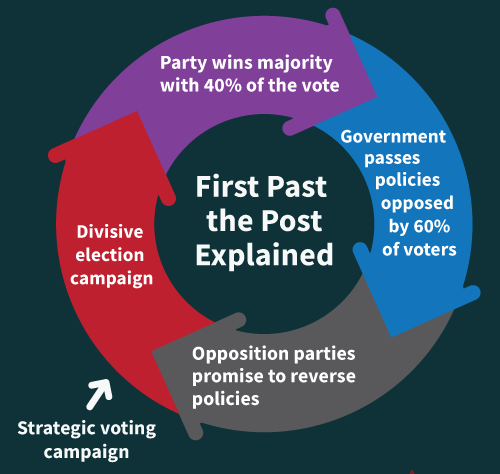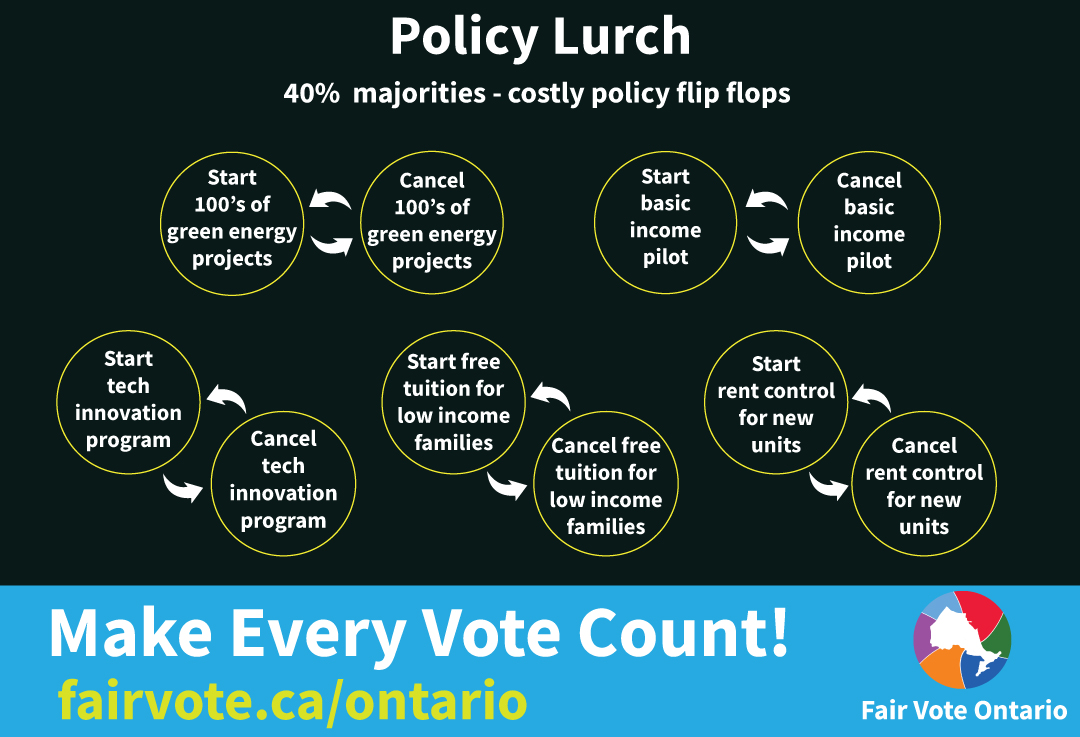
In just one year – June 2, 2022 – Ontario voters will head back to the polls to determine if Doug Ford’s government gets another “mandate”.
In 2018, the PC’s were elected to a “majority” with just 40.5% of the popular vote. Voter turnout was only 56.7%. Boiled down: 23% of eligible Ontario voters handed a single party 100% of the power for four years.
Thanks to our archaic, winner-take-all voting system, this is how democracy “works” in Ontario. The last time Ontario had a majority government elected by an actual majority of voters was in 1937!
The past three years have been a relentless onslaught of “policy lurch”: the extreme policy swings and policy reversals when a false majority government of one stripe replaces another.
Policy lurch wastes every voter’s time and money. Policy lurch stalls progress on important long-term issues while we swing back and forth, assembling and dismantling programs. It causes constant instability for business. And it can turn people’s lives upside down.
Policy lurch is one of the most destructive outcomes of our winner-take-all voting system.
Only proportional representation can stop policy lurch, and put us on the path to governance that puts the public interest first.
Policy lurch has been happening for decades, but the list of costly examples in Ontario over the past three years alone is staggering:
- Cancelled: Over 700 renewable energy projects – resulting in hundreds of millions in broken contract costs and compensation costs due to lawsuits
- Cancelled: Basic Income Pilot – massively impacting the lives of participants and preventing the most useful data from being collected
- Cancelled: Free university tuition for low income families – throwing a wrench in student plans and increasing debt for low income students
- Reversed: Pledge to make Indigenous courses mandatory in secondary schools – in line with the recommendations of the Truth and Reconciliation Commission
- Cancelled: 100 million dollar fund for school repair
- Reversed: Legislation that allowed municipalities to choose their own voting systems – which would have allowed some cities to choose proportional systems in the future.And these are just a few examples.
In many cases, all three opposition parties will soon be loudly promising to reverse the reversals!
In fact, these kinds of “we’ll bring back” and “we’ll undo” election promises can make up a large part of a party’s platform―taking up the valuable time of a new government to achieve.
Only proportional representation can stop the worst of this wasteful and destructive cycle before it gets started.
Proportional representation ensures that every policy―no matter which government is in power―has majority support in the first place!
This means policies are developed through real collaboration between multiple parties, with different perspectives.
Proportional representation means policies build on a stronger foundation.
That’s more stability for everyone – citizens and businesses – when policies are built to last.
Whether it’s economic prosperity, environment, or health and well being, when we look at the long-term picture, the research is clear: Countries with proportional representation perform better for everyone. Cooperation works!
And cooperation is exactly what Ontario citizens want. Last September, a poll by Leger showed that an overwhelming number of Ontarians support:
- A system that encourages parties to work together more in the public interest (96% support)
- Ensuring that laws passed have the support of parties representing at least 50% of voters (94% support)
It’s time to put electoral reform back on the agenda in Ontario!

